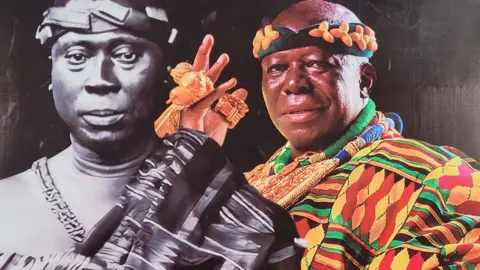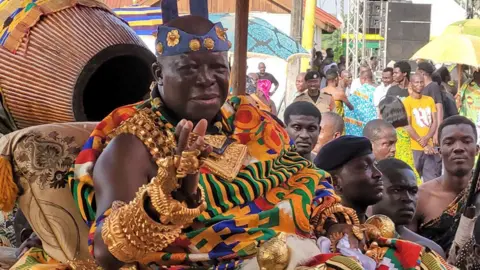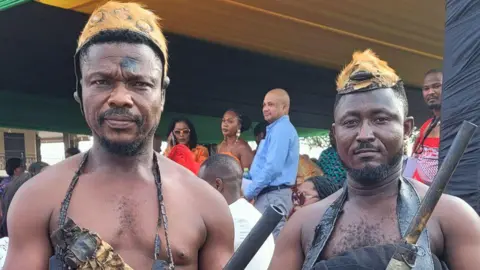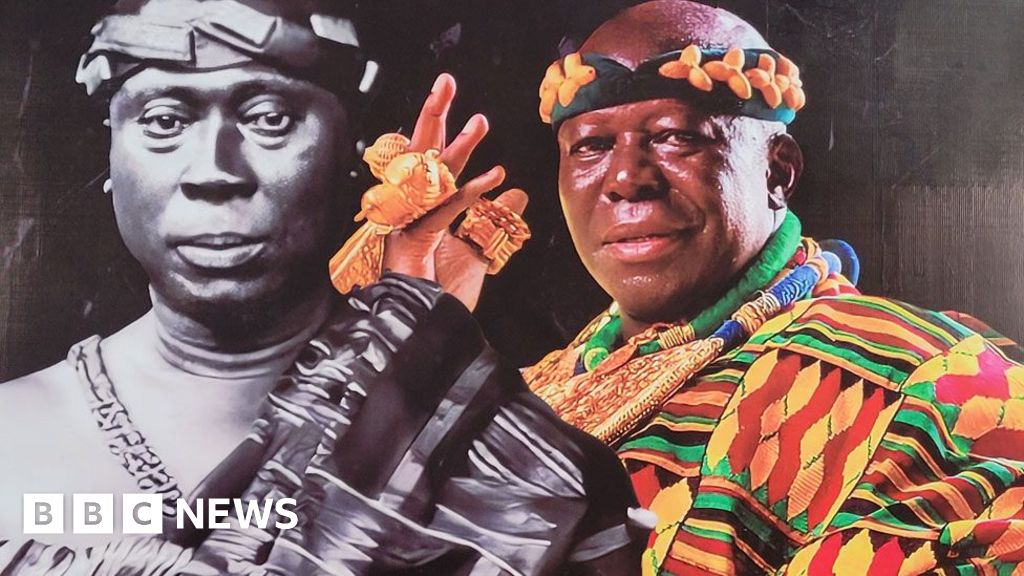 Barnaby Phillips
Barnaby PhillipsThe sector outdoors the royal palace within the Ghanaian metropolis of Kumasi was full of an exuberant crowd, celebrating the return 100 years in the past of an exiled king.
Prempeh was the Asante king, or “Asantehene”, of the late nineteenth Century who resisted British calls for that his territory be swallowed up into the increasing Gold Coast protectorate.
A British military from the coast marched about 200km (124 miles) to Kumasi in 1896, and took Prempeh in addition to about 50 family members, chiefs and servants as prisoners, after which looted his palace.
The prisoners have been taken to the coastal fort at Elmina, earlier than being shipped to Sierra Leone, and, in 1900, on to the distant Indian Ocean islands of Seychelles.
It was not till 1924 that the British allowed Prempeh to return residence, by which era he was an aged man who arrived in Kumasi sporting a European go well with and hat.
It’s a tragic story, but additionally one in every of satisfaction and resistance.
“The British did all they may however they couldn’t break the spirit of Asante,” shouted the grasp of ceremonies. The present Asantehene, Osei Tutu II, was paraded on his palanquin by the group, weighed down by magnificent gold jewelry, amid an excellent cacophony of musket explosions, drum beats and the blare of horns constructed from elephant tusks.
Asante tradition is alive and properly.
 Barnaby Phillips
Barnaby PhillipsHowever Prempeh’s exile did have an enduring affect on each the Asante kingdom and Seychelles, though maybe not in methods supposed by British officers on the time.
The visitor of honour on the centenary celebrations, held in Kumasi on the weekend, was Seychelles’ President Wavel Ramkalawan, who stated “it was an honour, although unhappy, for us to obtain your nice king”.
“He confirmed respect to our individuals, and in return acquired the complete love of the Seychelles,” Ramkalawan added.
The proof of that’s in household ties cherished to this present day.
Princess Mary Prempeh Marimba is Prempeh’s great-grand-daughter. Her grandfather, James, the son of Prempeh, married a Seychellois lady, and initially stayed on the islands after his father left.
Mary is a nursing supervisor in Seychelles’ capital, Victoria, and travelled to Kumasi together with her daughter Suzy, to re-unite with dozens of long-lost family members and uncover extra about her Asante heritage.
“There are such a lot of combined feelings, my great-grandfather had so many difficulties, and it is a unhappy historical past, however I additionally come right here and have a good time with my household,” she stated.
The Asante exiles in Seychelles lived in “Ashanti City”, on an outdated sugar plantation, Le Rocher, on the principle island Mahé, overlooking the ocean and surrounded by coconut, mango, breadfruit, orange and jackfruit bushes.
Prempeh lived within the property’s villa, and was given “each respect and dignity”, in response to Dr Penda Uneven, a Seychellois tutorial who additionally travelled to Kumasi for the centenary occasions.
In 1901, the Asante group grew, as Yaa Asantewaa, a queen who led the ultimate resistance to the British, and a few 20 chiefs and attendants, have been additionally despatched to Seychelles following their give up.
 Barnaby Phillips
Barnaby PhillipsThe lengthy years of exile modified Prempeh. He learnt to learn and write, and urged the Asante youngsters to attend faculty.
He embraced Christianity, and, within the phrases of Asante historian and politician Albert Adu Boahen, “rigidly and uncompromisingly imposed that faith on his fellow political prisoners and their youngsters.
Within the Anglican Church of St Paul’s, the Asante weren’t the one exiles within the congregation, for they typically sat with King Mwanga of Buganda and King Kabalega of Bunyoro, each from modern-day Uganda.
Certainly, at numerous occasions, the British additionally despatched political prisoners from Egypt, Palestine, Zanzibar, the Maldives, Malaysia and Cyprus to Seychelles, which was generally known as a “jail with out bars”, as its isolation made the proper location, from the British perspective, to place troublesome opponents.
The years glided by, and Prempeh dreamt of residence.
In 1918, he wrote to King George V and pleaded to be allowed to return.
“Take into account how wretched I’m for I used to be being taken prisoner… for now 22 years, and now how depressing to see that father, mom, brother and almost three quarters of the chiefs are lifeless. The remaining quarter, some are blind, some worn out with outdated age and the remainder being attacked of various illnesses,” Prempeh wrote.
Just a few years later, the British, maybe conscious that Prempeh’s potential demise in exile might deliver political issues in Asante, lastly relented.
In November 1924 Prempeh travelled by ship again to West Africa with some 50 Asante companions, most of whom had been born in Seychelles.
“We who have no idea him are greater than anxious to see his face,” wrote a distinguished native newspaper, The Gold Coast Chief.
In Kumasi, many slept by the prepare station to greet him and, in response to a British official, “the scene offered by the massive meeting…. with their white head bands signifying rejoicing or victory, some laughing and cheering, whereas others wept with emotion, was a most shifting and never-to-be-forgotten sight”.
In idea “Mr Edward Prempeh” was now a non-public citizen, however his individuals handled him as a king, and offered him with royal regalia, together with the Golden Stool, stated to include the soul of the Asante nation.
 Barnaby Phillips
Barnaby PhillipsPrempeh died in 1931, and his successor, Prempeh II, was restored to the place of Asantehene in 1935.
Ivor Agyeman-Duah, an Asante scholar and director of the palace museum, helped organise the centenary celebrations.
They have been of added private significance, as his nice grandfather, Kwame Boatin, was one of many chiefs exiled alongside Prempeh.
However as Mr Agyeman-Duah acknowledges, exile, for all its ache, additionally introduced alternatives for many who suffered it.
Kwame Boatin’s youngsters went on to be ambassadors and main civil servants, capable of adapt to the dramatic adjustments that Asante, the Gold Coast and later an impartial Ghana, underwent within the twentieth Century.
“The exiles had been uncovered to the world, and so they had one thing to contribute,” he stated. “What they introduced again nonetheless conjures up us, their dedication to scholarship and public service.”
In a village one hour’s drive from Kumasi, I met Princess Molly Prempeh, an animated woman in her 80s, and in addition a great-granddaughter of Prempeh.
“I’m the one remaining particular person right here who was born in Seychelles,” she instructed me.
“I’m Seychellois and Ghanaian – I used to be 5 years outdated after I got here again.”
In her outdated age, Molly has reconnected with the attractive islands of her start, and visited twice.
The Seychellois are delighted by the “Previous Creole”, which incorporates extra French phrases, she remembers from childhood.
“Once I stroll down the streets they shout ‘Heh Princess, how are you?’ ‘Princess, venez, venez, tu bien?’ (come, come right here, you good?) they’re pretty individuals. They love the Prempehs in Sesel (Seychelles).”
However Molly’s visits are additionally tinged with unhappiness. She goes to the grave of her mom, Hugette, who introduced Molly as a younger lady to the Gold Coast in 1948.
Hugette later returned to Seychelles, the place she ultimately died.
Even in her outdated age, the story goes, she cherished to talk the Twi language she had been taught as a bit lady by Prempeh herself.
One household’s story of loss, exile and endurance.
Barnaby Phillips is a former BBC correspondent and writer of Loot; Britain and the Benin Bronzes
Extra BBC tales about Ghana:
 Getty Photographs/BBC
Getty Photographs/BBC











